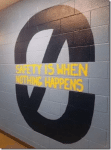Disrupting the Methodology in Safety? There seems a real focus at the moment on finding better and ‘different’ ways (or methods) to ‘do’ Safety; both in organisations and for those working in the field. There is a lot of good discussion happening and in particular, it is positive to note that much … [Read more...] about Disrupting the Methodology in Safety?
Disruptive Safety
Zero to HRO (High Reliability Organisation) – Updated
Despite all the latest trendy spin about safety disruption the language in this paper was considered to be too “inflammatory” for publication in a mainstream traditional Safety Journal (download it and you will see why) – so it gives me great pleasure to publish it here. Updated March 2017, from the … [Read more...] about Zero to HRO (High Reliability Organisation) – Updated


